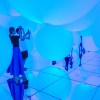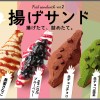Oftentimes, it’s what we don’t see that tells the real story of the people smiling at the world online.
Last month a chill went down the spine of Japanese Twitter users as they looked at an illustration of a child reaching into a refrigerator to grab a pack of pudding…and also reaching past the stockpile of alcohol required by his alcoholic parents. But while that picture was indeed worth a thousand words, often the thousand words of a snapshot shared on social media isn’t enough to tell the whole story of a person’s life.
And so @avogado6, the same artist behind the refrigerator illustration, is back with another drawing, this one titled “What does your eye see?”
その眼には何が写る pic.twitter.com/Y9IoO2grCp
— アボガド6 (@avogado6) October 16, 2017
At a quick glance, it looks like a pretty happy moment. A young lady with a beaming smile flashes a selfie as she sits in her apartment, with a cup of coffee and slice of strawberry shortcake on the table in front of her. But let your gaze zoom out to the gray outer areas, which actually make up the majority of the drawing, and things start to look very different.
Outside the frame of the photo, the woman’s apartment is decidedly dilapidated. Her furniture is collapsing, and trash and empty food and beverage containers littler the floor, revealing that her home life isn’t as happy or luxurious as the photo she’s sharing would imply.
But what really gives us a clue as to what’s going on are the dozens of strips of paper with “Ii ne!” written on them. Ii ne literally translates as “good,” but it’s also the term Japanese Internet users use to “like” something online.
Adding another layer to the surprisingly complex situation, the kanji character @avogado6 uses for “eye,” 眼, can also used to refer to a camera lens, so the title “What does your eye see?” could also be translated as “What does the camera see?”
Once the whole scene sunk in, it left a deep impression with those who saw it, prompting comments such as:
“What we see isn’t always how things really are.”
“If I’m buried in ‘likes,’ my life must be good, right?”
“What we see is only a small part of a person’s life, with so much more that we’re not aware of.”
“I can’t really say whether or not it’s good for us to show only our best points to other people, and to hide our faults and shortcomings. So I can’t really say what exactly my eye sees…”
“Looking at this makes so many thoughts run through my mind. I wonder what the people who upload photos are feeling, and whether it’s OK that we ‘like’ them as long as we enjoy what we see in that one picture. Something feels wrong, but even as I was thinking that, I clicked the ‘like’ button for this.”
The last commenter apparently wasn’t the only one to feel a mix of conflicting emotions. In an ironic twist, @avogado6’s tweet has been liked over 96,000 times in the two days since it was posted, Hopefully the periphery of the artist’s artwork, all the parts of his life that we don’t see, are less bleak than that of the woman taking the selfie.
Source: Twitter/@avogado6 via Jin

 Japanese Twitter artist illustrates six differences between imagined ideals and reality for women
Japanese Twitter artist illustrates six differences between imagined ideals and reality for women Social distancing ideals vs reality: Beautiful Thai woman reveals the difference【Photos】
Social distancing ideals vs reality: Beautiful Thai woman reveals the difference【Photos】 Instagram ideals vs reality: “Boyfriend buys me Pocari Sweat” photo isn’t what it seems
Instagram ideals vs reality: “Boyfriend buys me Pocari Sweat” photo isn’t what it seems Japanese Twitter artist draws manga of “Aspe-chan” to show what it’s like living with Asperger’s
Japanese Twitter artist draws manga of “Aspe-chan” to show what it’s like living with Asperger’s Japanese beef bowl chain Sukiya’s 2026 Smile Box lucky bag basically pays for itself
Japanese beef bowl chain Sukiya’s 2026 Smile Box lucky bag basically pays for itself Hayao Miyazaki says Happy New Year to Studio Ghibli fans with new art for Year of the Horse
Hayao Miyazaki says Happy New Year to Studio Ghibli fans with new art for Year of the Horse What did Shibuya really look like after the crowds on New Year’s Day?
What did Shibuya really look like after the crowds on New Year’s Day? 7 great places to see Mt. Fuji from without having to climb it
7 great places to see Mt. Fuji from without having to climb it TeamLab Planets: Walk up a waterfall and catch koi fish at new digital art museum in Tokyo
TeamLab Planets: Walk up a waterfall and catch koi fish at new digital art museum in Tokyo Fried sandwiches arrive in Tokyo, become hot topic on social media
Fried sandwiches arrive in Tokyo, become hot topic on social media Ghibli Museum Attracts 10 Million Visitors
Ghibli Museum Attracts 10 Million Visitors 10 things one Japanese expat is always sure to stock up on when returning to Japan
10 things one Japanese expat is always sure to stock up on when returning to Japan 7 reasons why you should visit Aomori Prefecture
7 reasons why you should visit Aomori Prefecture Ichiran Ramen’s delicious new product: Fried tonkotsu noodles!
Ichiran Ramen’s delicious new product: Fried tonkotsu noodles! Starbucks Japan ready to get Year of the Horse started with adorable drinkware and plushies【Pics】
Starbucks Japan ready to get Year of the Horse started with adorable drinkware and plushies【Pics】 We found possibly the quietest Japanese-style hotel in Tokyo’s bustling Shinjuku district
We found possibly the quietest Japanese-style hotel in Tokyo’s bustling Shinjuku district Cup Noodle tries an authentic Jiro-style ramen, but something’s not quite right
Cup Noodle tries an authentic Jiro-style ramen, but something’s not quite right Hello Kitty Choco Egg figures are an adorable trip through three periods of Japanese pop culture【Pics】
Hello Kitty Choco Egg figures are an adorable trip through three periods of Japanese pop culture【Pics】 Japan’s oldest largetooth sawfish in captivity back on display in Mie Prefecture
Japan’s oldest largetooth sawfish in captivity back on display in Mie Prefecture Cyberpunk anime meets traditional culture in Ghost in the Shell gold leaf Japanese changing screens
Cyberpunk anime meets traditional culture in Ghost in the Shell gold leaf Japanese changing screens The best Starbucks Japan Frappuccinos we want to drink again in 2026
The best Starbucks Japan Frappuccinos we want to drink again in 2026 We revisited Sweets Paradise after a decade to see if Japan’s dessert buffet still delivers
We revisited Sweets Paradise after a decade to see if Japan’s dessert buffet still delivers 7-Eleven Japan starts new temporary luggage storage service in over 300 branches
7-Eleven Japan starts new temporary luggage storage service in over 300 branches Disillusionment at Tsukiji’s tourist-target prices led us to a great ramen restaurant in Tokyo
Disillusionment at Tsukiji’s tourist-target prices led us to a great ramen restaurant in Tokyo Starbucks teams up with 166-year-old Kyoto doll maker for Year of the Horse decorations【Photos】
Starbucks teams up with 166-year-old Kyoto doll maker for Year of the Horse decorations【Photos】 Tokyo considering law requiring more trash cans following litter increase in heavily touristed area
Tokyo considering law requiring more trash cans following litter increase in heavily touristed area Tokyo’s Tsukiji sushi neighborhood asks tour groups to stay away for the rest of the month
Tokyo’s Tsukiji sushi neighborhood asks tour groups to stay away for the rest of the month Tokyo event lets you travel back in time, for free, to celebrate 100 years since Showa era start
Tokyo event lets you travel back in time, for free, to celebrate 100 years since Showa era start Sanrio theme park in Japan announces plans to expand into a Sanrio resort
Sanrio theme park in Japan announces plans to expand into a Sanrio resort Japan may add Japanese language proficiency, lifestyle classes to permanent foreign resident requirements
Japan may add Japanese language proficiency, lifestyle classes to permanent foreign resident requirements Stamina-destroying “Paralysis Noodles” are Tokyo’s newest over-the-top ramen innovation
Stamina-destroying “Paralysis Noodles” are Tokyo’s newest over-the-top ramen innovation Survey asks foreign tourists what bothered them in Japan, more than half gave same answer
Survey asks foreign tourists what bothered them in Japan, more than half gave same answer Japan’s human washing machines will go on sale to general public, demos to be held in Tokyo
Japan’s human washing machines will go on sale to general public, demos to be held in Tokyo Japan’s deadliest food claims more victims, but why do people keep eating it for New Year’s?
Japan’s deadliest food claims more victims, but why do people keep eating it for New Year’s? We deeply regret going into this tunnel on our walk in the mountains of Japan
We deeply regret going into this tunnel on our walk in the mountains of Japan Studio Ghibli releases Kodama forest spirits from Princess Mononoke to light up your home
Studio Ghibli releases Kodama forest spirits from Princess Mononoke to light up your home Major Japanese hotel chain says reservations via overseas booking sites may not be valid
Major Japanese hotel chain says reservations via overseas booking sites may not be valid Put sesame oil in your coffee? Japanese maker says it’s the best way to start your day【Taste test】
Put sesame oil in your coffee? Japanese maker says it’s the best way to start your day【Taste test】 No more using real katana for tourism activities, Japan’s National Police Agency says
No more using real katana for tourism activities, Japan’s National Police Agency says Starbucks Japan reveals new sakura drinkware collection, inspired by evening cherry blossoms
Starbucks Japan reveals new sakura drinkware collection, inspired by evening cherry blossoms Updated cherry blossom forecast shows extra-long sakura season for Japan this year
Updated cherry blossom forecast shows extra-long sakura season for Japan this year A warning to think twice before taking photos of a crab dinner lying in a Japanese subway station
A warning to think twice before taking photos of a crab dinner lying in a Japanese subway station
Leave a Reply